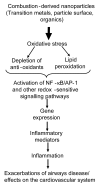Nanoparticles-a thoracic toxicology perspective
- PMID: 17722227
- PMCID: PMC2628054
- DOI: 10.3349/ymj.2007.48.4.561
Nanoparticles-a thoracic toxicology perspective
Abstract
A substantial literature demonstrates that the main ultrafine particles found in ambient urban air are combustion-derived nanoparticles (CDNP) which originate from a number of sources and pose a hazard to the lungs. For CDNP, three properties appear important-surface area, organics and metals. All of these can generate free radicals and so induce oxidative stress and inflammation. Inflammation is a process involved in the diseases exhibited by the individuals susceptible to the effects of PM- development and exacerbations of airways disease and cardiovascular disease. It is therefore possible to implicate CDNP in the common adverse effects of increased PM. The adverse effects of increases in PM on the cardiovascular system are well-documented in the epidemiological literature and, as argued above, these effects are likely to be driven by the combustion-derived NP. The epidemiological findings can be explained in a number of hypotheses regarding the action of NP:-1) Inflammation in the lungs caused by NP causes atheromatous plaque development and destabilization; 2) The inflammation in the lungs causes alteration in the clotting status or fibrinolytic balance favouring thrombogenesis; 3) The NP themselves or metals/organics released by the particles enter the circulation and have direct effects on the endothelium, plaques, the clotting system or the autonomic nervous system/ heart rhythm. Environmental nanoparticles are accidentally produced but they provide a toxicological model for a new class of purposely 'engineered' NP arising from the nanotechnology industry, whose effects are much less understood. Bridging our toxicological knowledge between the environmental nanoparticles and the new engineered nanoparticles is a considerable challenge.
Figures
Similar articles
-
A review of carbon nanotube toxicity and assessment of potential occupational and environmental health risks.Crit Rev Toxicol. 2006 Mar;36(3):189-217. doi: 10.1080/10408440600570233. Crit Rev Toxicol. 2006. PMID: 16686422 Review.
-
Airborne particulate matter and human health: toxicological assessment and importance of size and composition of particles for oxidative damage and carcinogenic mechanisms.J Environ Sci Health C Environ Carcinog Ecotoxicol Rev. 2008 Oct-Dec;26(4):339-62. doi: 10.1080/10590500802494538. J Environ Sci Health C Environ Carcinog Ecotoxicol Rev. 2008. PMID: 19034792 Review.
-
Combustion-derived nanoparticles: a review of their toxicology following inhalation exposure.Part Fibre Toxicol. 2005 Oct 21;2:10. doi: 10.1186/1743-8977-2-10. Part Fibre Toxicol. 2005. PMID: 16242040 Free PMC article.
-
Engineered nanoparticle respiratory exposure and potential risks for cardiovascular toxicity: predictive tests and biomarkers.Inhal Toxicol. 2009 Jul;21 Suppl 1:68-73. doi: 10.1080/08958370902942566. Inhal Toxicol. 2009. PMID: 19558236
-
Role of inflammation in cardiopulmonary health effects of PM.Toxicol Appl Pharmacol. 2005 Sep 1;207(2 Suppl):483-8. doi: 10.1016/j.taap.2005.02.020. Toxicol Appl Pharmacol. 2005. PMID: 15979665 Review.
Cited by
-
Pathway focused protein profiling indicates differential function for IL-1B, -18 and VEGF during initiation and resolution of lung inflammation evoked by carbon nanoparticle exposure in mice.Part Fibre Toxicol. 2009 Dec 2;6:31. doi: 10.1186/1743-8977-6-31. Part Fibre Toxicol. 2009. PMID: 19954533 Free PMC article.
-
Interaction and localization of synthetic nanoparticles in healthy and cystic fibrosis airway epithelial cells: effect of ozone exposure.J Aerosol Med Pulm Drug Deliv. 2012 Feb;25(1):7-15. doi: 10.1089/jamp.2011.0889. Epub 2011 Oct 18. J Aerosol Med Pulm Drug Deliv. 2012. PMID: 22007674 Free PMC article.
-
Expert elicitation on ultrafine particles: likelihood of health effects and causal pathways.Part Fibre Toxicol. 2009 Jul 24;6:19. doi: 10.1186/1743-8977-6-19. Part Fibre Toxicol. 2009. PMID: 19630955 Free PMC article.
-
In vitro assessments of nanomaterial toxicity.Adv Drug Deliv Rev. 2009 Jun 21;61(6):438-56. doi: 10.1016/j.addr.2009.03.005. Epub 2009 Apr 19. Adv Drug Deliv Rev. 2009. PMID: 19383522 Free PMC article. Review.
-
Mast cells contribute to altered vascular reactivity and ischemia-reperfusion injury following cerium oxide nanoparticle instillation.Nanotoxicology. 2011 Dec;5(4):531-45. doi: 10.3109/17435390.2010.530004. Epub 2010 Nov 3. Nanotoxicology. 2011. PMID: 21043986 Free PMC article.
References
-
- Royal Society and Royal Academy of Engineering. Nanoscience and nanotechnologies: opportunities and uncertainties. The Royal Society; 2004.
-
- Seaton A, MacNee W, Donaldson K, Godden D. Particulate air pollution and acute health effects. Lancet. 1995;345:176–178. - PubMed
-
- Utell MJ, Frampton MW. Acute health effects of ambient air pollution: the ultrafine particle hypothesis. J Aerosol Med. 2000;13:355–359. - PubMed
-
- Quality of Urban Air Review Group. Airborne particulate matter in the United Kingdom: third report of the Quality of Urban Air Review Group. Quality of Urban Air Review Group. Quality of Urban Air Review Group; 1996.
Publication types
MeSH terms
Substances
LinkOut - more resources
Full Text Sources
Miscellaneous



